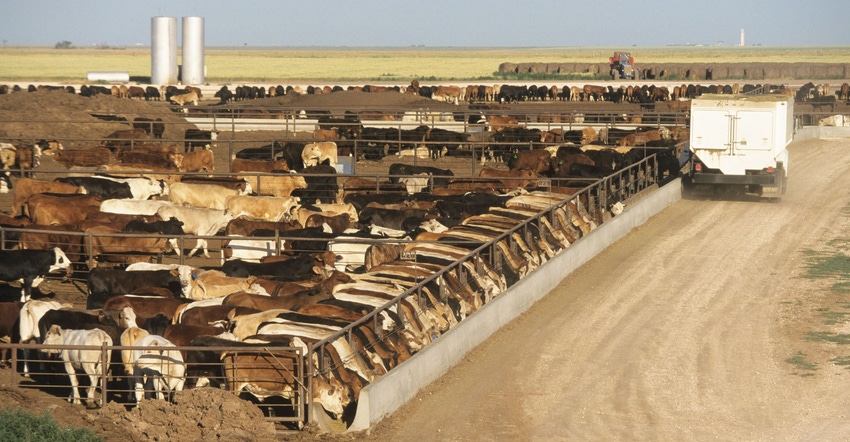February 12, 2021

When discussing greenhouse gases, a critical measure is methane. The gas has greater impact than carbon dioxide on climate science, and often livestock are considered the key culprit. A Dutch company may have found the answer for cattle contributions with a feed additive that cuts methane emissions from livestock by as much as 80%.
The product was demonstrated in a large-scale trial in Canada, conducted over two years and involving 15,000 cattle.
But how do you measure methane from 15,000 cattle to know the product works?
Farm Progress connected with Maik Kindermann, inventor and innovation project director, Royal DSM, and Mark van Nieuwland, Royal DSM vice president and director of the Clean Cow project, to dig into the product, measuring methane and what this might mean for beef and dairy operations.
Measuring methane
The two-year trial in Alberta, Canada, tested the novel ingredient — 3-NOP — and proved it could reduce methane at scale in commercial conditions. To conduct the trial, the company and its research partners faced the huge challenge of reliably measuring methane levels for a test involving 15,000 animals.
“Historically we were measuring methane in chambers, but they're not numerous enough for such a large number of cattle,” Kindermann said.
The company turned to a third-party firm using mobile devices (GreenFeed systems) to measure emission data from ruminants.
“If you measure enough of the animals you can extrapolate the result to the entire herd,” Kindermann said. ��“We also did explore new measurement methods such as laser grids and drones.”
When scaling from animal to pen level, the laser grid proved an effective way to assess the reduction of methane emissions.
“You then measure the air that is entering upwind of the pen and then downwind,” Kindermann said. “These measurement techniques are so sensitive that you can detect the amount of methane leaving the pen.”
He explained the laser grid “pen” of animals included 250 head at a time. Using several measurements of different cattle groups, it is possible to extrapolate total methane for the herd, and then also calculate reduction, Kindermann said.
The research community will push for further advanced measurement methods including the use of drones, and even an airplane. “But that is the future,” he added.
A feed ingredient at work
The feed additive that Royal DSM developed is 3-NOP. Kindermann explained that in the cow’s rumen, methane is produced by microorganisms while digesting the feed. “And within a specific group of microorganisms (methanogens; archea) there is a cascade of steps within a biological pathway, that at the end releases methane in the rumen and then the cow burps it out,” he explained.
The 3-NOP additive is a molecule that slows down that last step of methane formation. The result is a reduction of methane release as high as 80%.
Van Nieuwland explained that the product is composed of nitrate and an alcohol and that this molecule binds to the enzyme Kindermann referenced and inhibits that methane formation. “So that prevents the enzyme from taking that action and as part of the mode of action, it actually falls apart into two natural fragments that it is made of and that are already part of the regular metabolism of the cow,” he noted.
He added that people ask if 3-NOP will end up in milk for a dairy herd or the meat of a beef animal. “The answer is no, because actually by its own mode of action it gets destroyed (in the process),” he said.
Kindermann admitted that at first, they were not aware that the product would break down as it does. “This was not planned when we developed (3-NOP) of course, but sometimes luck is also an important element of research,” he noted.
Ingredient payback
Just reducing methane emissions doesn’t exactly offer a direct payback, but that is changing. Just what did that Alberta trial show?
During the trial, measurements indicated a reduction of enteric methane by an average of 70% when the feed ingredient was proved in steam-flaked or dry-rolled barley finishing diets at 125 mg/kg of feed dry matter. In steam-flaked corn-based finishing diets, the reduction ranged from 31% to 80% at the 125 mg/kg dosage. In backgrounding diets, increasing the dose of the feed ingredient stepwise from 150 to 200 mg/kg decreased methane yield by 17% to 26% compared with control animals. The trial showed the ingredient can be used in commercial feedlot diets to reduce methane emissions with no negative impact on animal health or performance.
DSM measured the value of the greenhouse gas reduction showing that during the trial, cattle reduced their greenhouse gas emissions by 1,473 equivalent tons of carbon dioxide, which is the same as taking 500 cars off the road for a year. Van Nieuwland added that many cattle herds are looking at ways to become net-zero for carbon emissions, or the opportunity to sell the value of methane reductions into a potential carbon market.
“One reason we did this specific study on Alberta is because, of course, there is a large beef market, but it also has a carbon credit market for the beef sector,” van Nieuwland said. “If you can, as a feedlot operator, demonstrate you produce less greenhouse gases, you can actually get credits and those are traded today."
The product is being filed as a novel feed ingredient for commercial registration using the trade name Bovaer in various parts of the world.
About the Author(s)
You May Also Like






